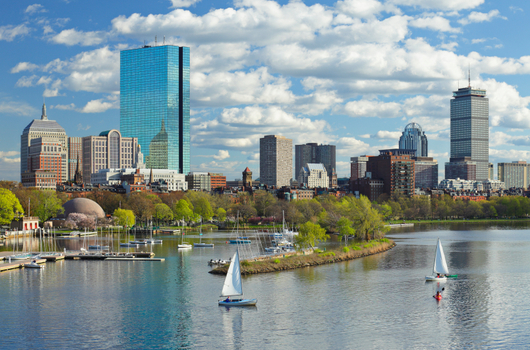Boston comes top of the class for energy efficiency

Boston comes top of the class for energy efficiency
The American Council for an Energy Efficient Economy (ACEEE) <aceee.org> ranks the largest cities in the United States on their energy efficiency policy and program efforts. Every other year, the results are released, along with recommendations for ways cities can improve.
The goal (beyond bragging rights for leaders) is to encourage cities to use efficiency as a “pragmatic and effective strategy for promoting economic growth, securing environmental benefits, and increasing their communities’ resilience in the face of the uncertain costs and supplies of the energy resources on which they depend.”
The 2015 scorecard is out, and once again Boston tops the charts, with Oklahoma City coming in last (51st).
1. Boston 82/100
Boston’s varied strategies work to reduce energy use and greenhouse gas emissions from municipal buildings, streetlights, transportation, and procurement. The 2014 plan (updated from 2011), will modify existing and add new strategies to meet or exceed the already established goal of reducing Boston's greenhouse gas emissions 25% by 2020. In achieving this, Boston will set sector-specific GHG targets, as well as program participation targets to meet the goal of 25% reduction.
2. New York City 78/100
Their focus is on two building energy efficiency program areas that are expected to be responsible for more than half of municipal greenhouse gas reductions, namely building retrofits and improvements to building operations and maintenance.
3. Washington 76.5/100
The Sustainable DC initiative describes strategies for various policy areas including energy, climate and environment, transportation, and the built environment. The DC Office of Planning (OP) and the District Department of the Environment (DDOE) lead the Sustainable DC Project.
4. San Francisco 75.5/100
Annual Departmental Climate Action Plans track vehicle fuel usage, building energy usage, water usage, and employee behavior. The San Francisco Department of the Environment (SF Environment) largely coordinates city departments through the climate action planning process. Electricity is supplied to city departments and other customers by the San Francisco Public Utilities Commission (SFPUC), the city's municipally owned electric utility. The SFPUC offers energy efficiency services to city departments and directly funds many of the resulting projects.
5. Seattle 75/100
Seattle’s Climate Action Plan details the city’s energy-related strategies for its internal government operations, including expanding the city’s electric vehicle fleet and developing a resource conservation plan for municipal buildings. The Office of Sustainability and Environment is largely responsible for coordinating city departmental efforts toward the government operations goal.
6. Chicago 69.5/100
Sustainable Chicago 2015 is the city’s framework for reducing energy usage and greenhouse gas emissions both within local government operations and community-wide. Some of the local government operations goals and strategies included are those to increase energy efficiency in municipal buildings, improve sustainability at Chicago’s airports, and reduce municipal fossil fuel consumption in the vehicle fleet.
7. Minneapolis 67/100
Greenprint, a subset of the Minneapolis Sustainability Indicators, is Minneapolis’s framework for sustainability and tracks progress in several policy areas such as transportation alternatives, waste and recycling, climate change, and renewable energy. In recent years, Minneapolis’s program for making its local government operations more energy efficient has been varied and has included strategies for public buildings, procurement, and the city-owned fleet.
8. Portland 66.5/100
Portland’s Climate Action Plan acknowledges that while city emissions account for a small fraction of Portland’s overall emissions, it is still important for the government to lead by example. To this end, Portland has established a significant and varied strategy for reducing its emissions that includes requiring energy efficient government buildings, procuring efficient vehicles, and incentivizing transit for government employees.
9. Austin 62.5/100
Austin’s Climate Program works with city departments to develop customized climate protection plans and implement strategies to achieve Austin’s overall local government goal. Departments’ climate protection plans reduce carbon emissions through different means and may focus on energy, fuel, water, or waste reduction initiatives or employee behavioral programs.
10. Denver 58.5
The Climate Action Plan and the Greenprint Denver Plan detail Denver’s aim to lead by example on matters of energy and greenhouse gas emissions. In particular, Denver is focusing on opportunities for energy efficiency and renewable energy at Denver’s airport, improvements in the city fleet, and the development of carbon neutral buildings.
51. Oklahoma City 12/100
Oklahoma City does not have an overarching plan for improving energy efficiency in the city’s internal government operations. The city does not currently require new public buildings to be ENERGY STAR® or LEED® certified. The city recently adopted a sustainable purchasing policy that requires life cycle costs for purchases. Oklahoma City does not use ENERGY STAR Portfolio Manager to manage energy use in local government buildings. The city is building and maintaining a facility database in EnergyCAP and is planning to incorporate it with Portfolio Manager.
Cities and counties that don’t make the scorecard but use the Local Energy Efficiency Self-Scoring Tool to generate scores equivalent to the rankings include Arlington County, Boulder, Burlington, Carrboro, Charlottesville, Dubuque, Knoxville, Lawrence, Madison and Park City.
Learn more and view the complete scorecard at http://database.aceee.org/city-scorecard-rank










